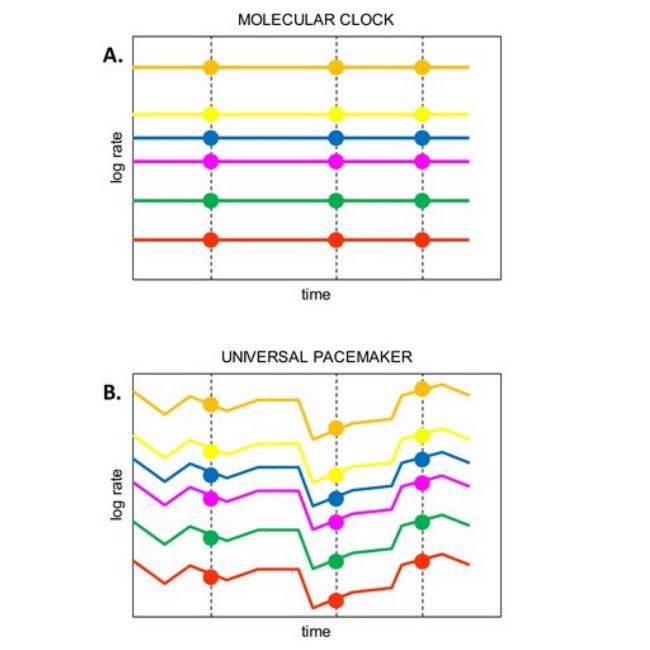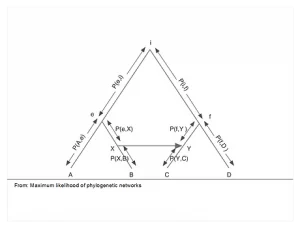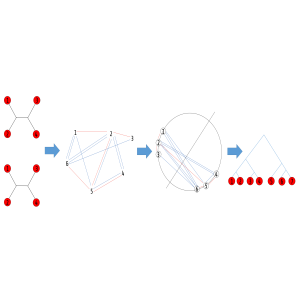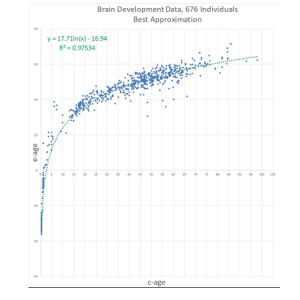Universal PaceMaker of Genome Evolution
Here we are collaborating with the Evolutionary Genomics group of Eugene Koonin at the NIH. We were awarded the BSF grant on a project tackling prokaryotic evolution, but are now looking at another, somehow broader, more fundamental evolutionary phenomenon. This project concerns with correlation between evolutionary rates of the various genes in the genome and was originated from our other project dealing with identifying HGT.
Gene evolution is traditionally considered within the classical framework of the Molecular Clock (MC) model [1] according to which each gene is characterized by an approximately constant rate of evolution. However, in a recent comparative analysis of numerous gene histories (gene phylogenies) we showed that a different model of evolution, denoted the Universal PaceMaker (UPM), which postulates conservation of relative, rather than absolute evolutionary rates, yields a better fit than the MC model to the phylogenetic data [2]. The UPM appears to be a key feature of genome evolution across the whole history of cellular life. This model is universal at two levels, first because it applies to all evolving lineages, and second, because it is a genome-wide phenomenon. While seemingly intuitive, it has never been either put into a rigorous comprehensive statistical framework or solved by analytic approaches, let alone verified on genome wide data in all life domains. The three papers covering all life domains [2,4,5], demonstrate vividly and rigorously the existence of a universal pace maker over the entire genome and spanning the whole Tree of Life. The paper presenting the approach [2] was selected for the (full) Research Highlight Section at the February 2013 issue of Nature Reviews Genetics [3]. The new concept of the UPM offers a wealth of practical and theoretical questions in the fields of Evolution/Statistics/Computer Science [6,7,8].
We anticipate a lot of work in all directions but certainly the most prominent one is elucidating the causes of the UPM phenomenon.
The generality of the UPM concept gave rise to its adaptation to epigenetic again – the Epigenetic Pacemaker project.


E. Zuckerkandl and L. Pauling. Molecules as documents of evolutionary history. J Theor Biol, 8(2):357–66, 1965.
S. Snir, Y. I. Wolf and E. V. Koonin. Universal Pacemaker of Genome Evolution. PLOS Computational Biology , 8(11): e1002785, 2012.
M. Muers. Evolution: Genomic pacemakers or ticking clocks? Nat. Rev. Genet., 14(81), 2013.
S. Snir, Y. I. Wolf, and E. V. Koonin. Universal pacemaker of genome evolution in animals and fungi and variation of evolutionary rates in diverse organisms. Genome Biology and Evolution. (GBE) 6 (6): 1268-1278, 2014.
Y. I. Wolf, S. Snir, and E. V. Koonin. Stability along with extreme variability in core genome evolution. Genome Biology and Evolution. (GBE). 5(7): 1393 – 1402, 2013.
S. Snir. On the Number of Genomic Pacemakers: A Geometric Approach. Algorithms for Molecular Biology. 9:26, 2014. Preliminary conference version appeared in WABI 2014.
S. Snir. Pacemaker partition identification. In Algorithms in Bioinformatics – 14th International Workshop, WABI 2014, September 8–10, 2014.
S. Snir. Bounds on Identification of Genome Evolution Pacemakers. Journal of Computational Biology. Preliminary conference version appeared in ISBRA 2018.





